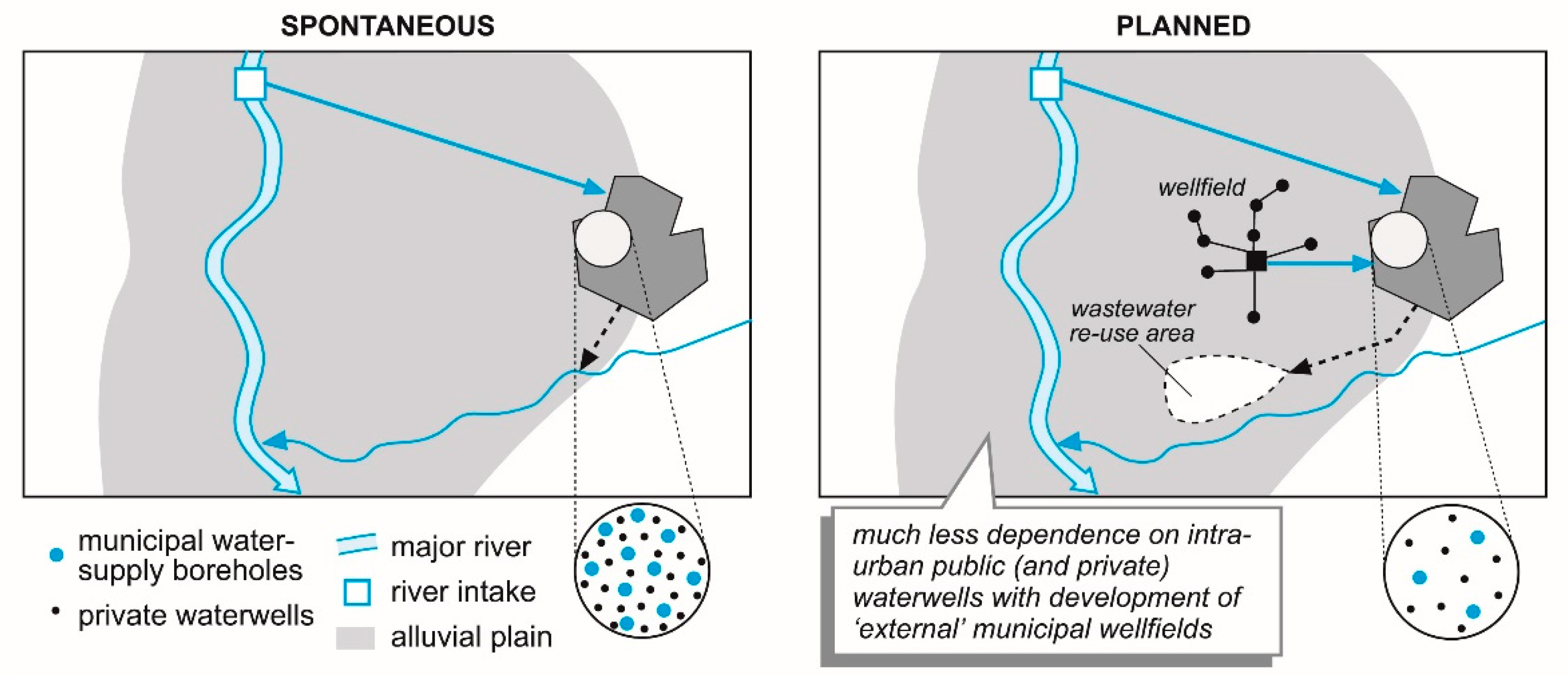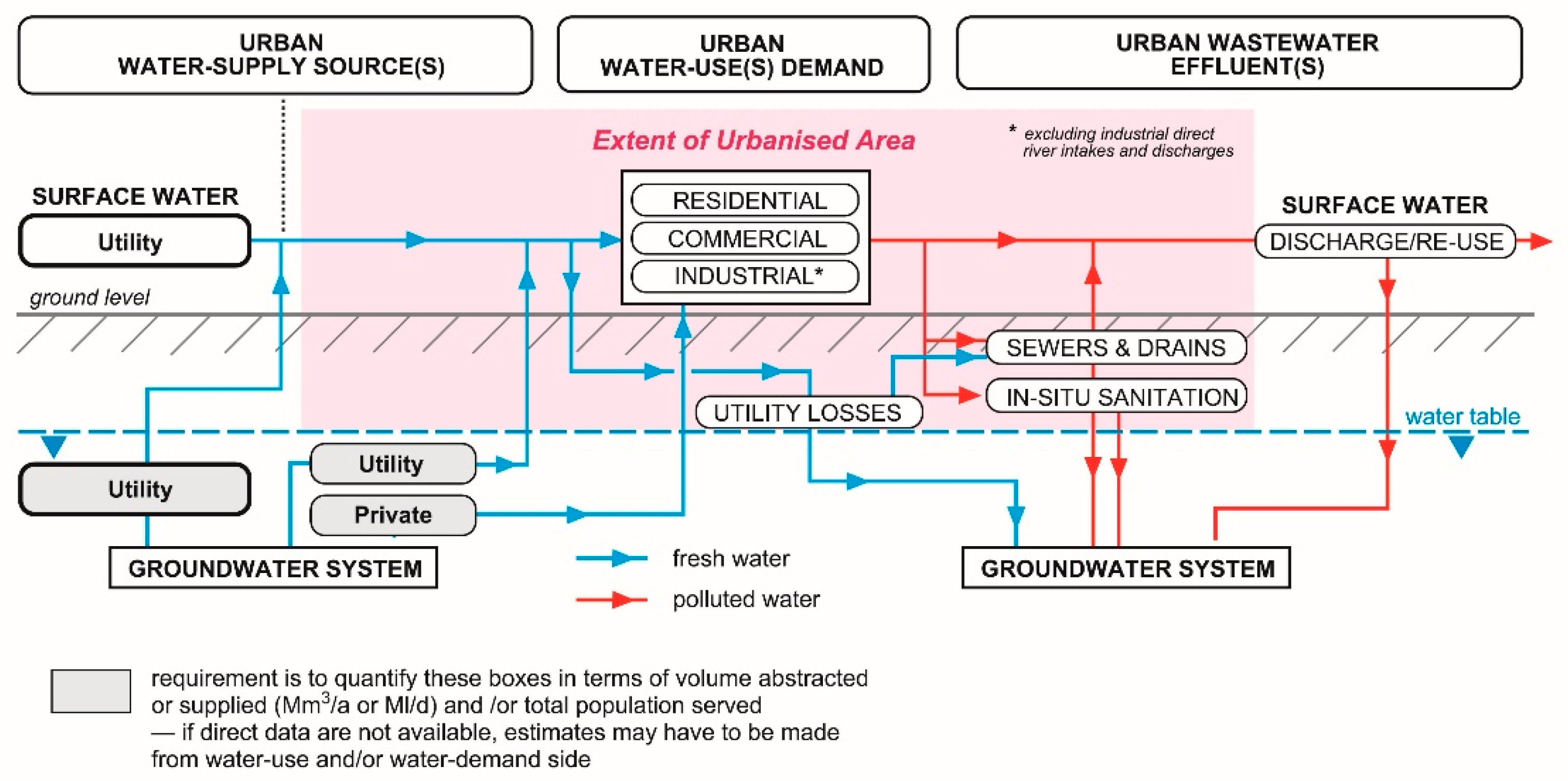Global Policy Overview of Groundwater in Urban Development—A Tale of 10 Cities!
Abstract
1. Objective of This Overview
2. Context for Policy Development
2.1. Drivers of Urban Groundwater
2.2. Major Issues Relating to Increased Groundwater Use
3. Urban Interactions with Groundwater
- substantially increasing recharge rates—since the reduction of infiltrating rainfall through land-surface impermeabilisation almost always is more than compensated for by water-mains leakage, infiltrating pluvial drainage and the incidental ‘return’ of wastewater from in-situ sanitation and sewer leakage, especially where the municipal water-supply is ‘imported from external sources’.
- greatly increased subsurface contaminant load, mainly from in-situ sanitation (in developing cities), and to lesser degree from sewer leakage and casual spillage/disposal of industrial and community chemicals.
- falling water-table due to excessive groundwater extraction, leading to land subsidence, building damage and increased surface-water flood risk (e.g., Bangkok/Table 1);
- water-table rebound, if groundwater use is abandoned for some reason such as serious pollution (e.g., Buenos Aires/Table 1), causing basement damage, groundwater flooding to transportation routes, malfunction of septic tanks and excessive inflows to deep collector sewers.
4. Integrating Groundwater into Urban Water and Land Management
4.1. Conserving Groundwater Reserves for Water-Supply Security
4.2. Incorporating Groundwater into Sanitation and Drainage Planning
- prioritisation of recently-urbanised districts for sewerage cover to protect their good-quality groundwater from gradual degradation;
- establishment of groundwater protection zones around utility waterwells favourably located to take advantage of parkland;
- imposition of better controls for the handling and disposal of industrial effluents and solid wastes to reduce the risk of aquifer pollution.
4.3. Private In-Situ Groundwater Use—Reducing Risks and Improving Benefits
- using advances in geographical positioning and data capture to locate waterwells;
- registering commercial/industrial users and residential use for apartment blocks/housing estates, and charging for groundwater use by waterwell pump capacity or metering discharges to sewers;
- issuing water-quality use advice and health warnings to private waterwell operators, and if pollution is severe, declaring sources unsuitable for potable use;
- gaining civil-society commitment through effective participatory mechanisms and incentives for ‘self-monitoring’.
4.4. Groundwater in Decentralised Urban Water-Service Provision
5. Filling the ‘Institutional Vacuum’ in Urban Groundwater
- water-resource agencies rarely have the capacity to cope with urban development dynamics;
- urban water utilities are often ‘resource illiterate’ despite increasing groundwater dependence;
- urban land and environment departments have a poor understanding of groundwater.
- constrain groundwater demand and limit abstraction by socio-economic and regulatory measures, so as to avoid excessive aquifer depletion and degradation;
- encourage the spread of groundwater abstraction for municipal water-supply over larger land areas, through the declaration of special conservation and/or protection areas;
- plan urban sanitation better and regulate the storage of industrial chemicals and handling of industrial effluents in the interest of much improved groundwater quality protection.
Funding
Acknowledgments
Conflicts of Interest
References
- Foster, S.; Hirata, R.; Misra, S.; Garduño, H. Urban Groundwater Use Policy–Balancing the Benefits and Risks in Developing Nations; GW-MATe Strategic Overview Series 3; World Bank: Washington, DC, USA, 2011; Available online: www.un-igrac.org (accessed on 1 September 2019).
- Foster, S.; van Steenbergen, F.; Zuleta, J.; Garduño, H. Conjunctive Use of Groundwater and Surface Water—From Spontaneous Coping Strategy to Adaptive Resource Management; GW-MATE Strategic Overview Series 2; World Bank: Washington, DC, USA, 2010; Available online: www.un-igrac.org (accessed on 1 September 2019).
- Buapeng, S.; Foster, S. Controlling Groundwater Abstraction and Related Environmental Degradation in Metropolitan Bangkok, Thailand; GW-MATe Case Profile Collection 20; World Bank: Washington, DC, USA, 2008; Available online: www.un-igrac.org (accessed on 1 September 2019).
- Foster, S.; Hirata, R.; Vidal, A.; Schmidt, G.; Garduño, H. The Guarani Aquifer Initiative—Towards Realistic Groundwater Management in a Transboundary Context; GW-MATe Case Profile Collection 9; World Bank: Washington, DC, USA, 2009; Available online: www.un-igrac.org (accessed on 1 September 2019).
- Tuinhof, A.; Foster, S.; van Steenbergen, F.; Talbi, A.; Wishart, M. Appropriate Groundwater Management Policy for Sub-Saharan Africa in Face of Demographic Pressure and Climatic Variability; GW-MATe Strategic Overview Series 5; World Bank: Washington, DC, USA, 2011. [Google Scholar]
- Howard, K.W.F. Urban Groundwater—Meeting the Challenge; IAH Selected Paper Series 8; Taylor & Francis: Oxford, UK, 2007. [Google Scholar]
- Taniguchi, M.; Dausman, A.; Howard, K.; Polemio, M.; Lakshmana, T. Trends and sustainability of groundwater in highly stressed aquifers. In Proceedings of the Symposium HS. 2 at the Joint Convention of the International Association of Hydrological Sciences (IAHS) and the International Association of Hydrogeologists (IAH), Hyderabad, India, 6–12 September 2009; Taniguchi, M., Dausman, A., Howard, K., Polemio, M., Lakshmana, T., Eds.; IAHS Press: Wallingford, UK, 2009. [Google Scholar]
- Foster, S.; Hirata, R. Groundwater use for urban development: Enhancing benefits and reducing risks. Water Front 2011, 21–29. [Google Scholar]
- Foster, S.; Bousquet, A.; Furey, S. Urban groundwater use in Tropical Africa-a key factor in enhancing water security? Water Policy 2018, 20, 982–994. [Google Scholar] [CrossRef]
- Resilient Cities and Groundwater. IAH Strategic Overview Series. Available online: https://iah.org/wp-content/uploads/2015/12/IAH-Resilient-Cities-Groundwater-Dec-2015.pdf (accessed on 1 September 2019).
- Morris, B.L.; Seddique, A.A.; Ahmed, K.M. 2003 Response of the Dupi Tila Aquifer to intensive pumping in Dhaka-Bangladesh. Hydrogeol. J. 2003, 11, 496–503. [Google Scholar] [CrossRef]
- Lyu, H.M.; Sun, W.J.; Shen, S.L.; Arulrajah, A. Flood risk assessment in metro systems of mega-cities using a GIS-based modeling approach. Sci. Total Environ. 2018, 626, 1012–1025. [Google Scholar] [CrossRef] [PubMed]
- Lyu, H.M.; Shen, S.L.; Zhan, A.; Yang, J. Risk assessment of mega-city infrastructure related to land subsidence using improved trapezoidal FAHP. Sci. Total Environ. 2019, 135310. [Google Scholar] [CrossRef] [PubMed]
- Foster, S.; Hirata, R.; D’Elia, M.; Paris, M. Groundwater Quality Protection—A Guide for Water-Service Companies, Municipal Authorities and Environment Agencies; GW-MATe Publication; World Bank: Washington, DC, USA, 2007; Available online: www.un-igrac.org (accessed on 1 September 2019).
- Sun, R.; Jin, M.; Giordano, M.; Villholth, K. Urban and rural groundwater use in Zhengzhou—China: Challenges in joint management. Hydrogeol. J. 2009, 17, 1495–1506. [Google Scholar] [CrossRef]
- Foster, S.S.D.; Chilton, P.J. Downstream of downtown–urban wastewater as groundwater recharge. Hydrogeol. J. 2004, 12, 115–120. [Google Scholar] [CrossRef]
- Gronwall, J.T.; Mulenga, M.; McGranahan, G. Groundwater and Poor Urban Dwellers—A Review with Case Studies of Bangalore and Lusaka; IIED Human Settlements Working Paper 25; International Institute for Environment and Development: London, UK, 2010. [Google Scholar]
- Vairavamoorthy, K.; Tsegaye, S.; Eckart, J. Urban water management in cities of the future: Emerging areas in developing countries. Water Front 2011, 42–48. [Google Scholar]


| CITY Country | POPULATION * Utility Water-Supply | MAIN ISSUES AND CONCERNS | MANAGEMENT APPROACH |
|---|---|---|---|
| BANGKOK Thailand [3] | 8 million; 1200 Ml/d (5%–10% groundwater) | Municipal groundwater use constrained but massive private waterwell construction into the 1990s, causing land subsidence and other impacts | Water utility groundwater use drastically reduced; groundwater resource regulator empowered to control private waterwell use |
| LUCKNOW India [1] | 3 million; 500 Ml/d (50% groundwater) | Declining water-table/well yields; in-situ sanitation causing high nitrate levels in a shallow aquifer; uncontrolled private waterwell drilling | Accidental/incidental conjunctive use by the water-service utility since 1973 but groundwater use requires adequate planning and new protected sources |
| AURANGABAD India [1] | 1 million; 150 Ml/d (0% groundwater) | Poor utility water-service led to excessive private waterwell drilling in an aquifer of limited storage and polluted by universal in-situ sanitation | Supplementary water source needed; water-service utility needs to embrace private waterwell use (30+ Ml/d) and prioritise the sewerage system |
| LIMA Peru [2] | 8 million; 1100 Ml/d (30% groundwater) | Declining groundwater levels/reserves and increasing saline intrusion from excessive water utility/industrial abstraction in the 1980s–1990s | The government commissioned a water utility who successfully controlled public/private waterwell use and implemented conjunctive management |
| BUENOS AIRES Argentina [1] | 4 million; 500 Ml/d (20% groundwater) (reduced since 1990) | Utility/industrial waterwell use reduced in the late 1980s (due to pollution fears); strong water-table rebound caused groundwater flooding | Multi-stakeholder task-force on urban groundwater needed; some water-utility pumping must be maintained for water-supply/drainage purposes |
| NATAL Brazil [1] | 1 million; 280 Ml/d (100% groundwater) | In-situ sanitation causing groundwater nitrate pollution widely to 50+ mg/L; seawater intrusion concerns | Water utility prioritising sewage for aquifer protection and harmonising private waterwell use (45 Ml/d) |
| RIBEIRÃO PRETO Brazil [4] | 1 million; 500 Ml/d (100% groundwater) | Groundwater levels have fallen by 50+ m since 1970, with increased pumping costs and some pollution risks | Institutional agreement on urban waterwell drilling ban; improved monitoring and protection measures for public water-supply sources |
| ADDIS ABABA Ethiopia [5] | 3 million; 400 Ml/d (50% groundwater) | Severe water-supply shortage being partly met by new deep wellfield development | Improved monitoring and management of limited groundwater resources needed to avoid conflicts |
| DAR-es-SALAAM Tanzania [5] | 5 million; 350 Ml/d (10% groundwater) | Surface-water sources decreasing in reliability; major private waterwell use (80+ Ml/d) but aquifer widely polluted by in-situ sanitation | Developing major new municipal wellfields in rural areas with favourable groundwater conditions to the south |
| NAIROBI Kenya [5] | 4 million; 500 Ml/d (10% groundwater) | Surface-water sources decreasing in reliability; major private waterwell drilling (90–280 Ml/d) but groundwater levels have fallen by 50+ m | Metering/charging of private waterwells, with a moratorium on drilling and licensing new waterwells |
© 2020 by the author. Licensee MDPI, Basel, Switzerland. This article is an open access article distributed under the terms and conditions of the Creative Commons Attribution (CC BY) license (http://creativecommons.org/licenses/by/4.0/).
Share and Cite
Foster, S. Global Policy Overview of Groundwater in Urban Development—A Tale of 10 Cities! Water 2020, 12, 456. https://doi.org/10.3390/w12020456
Foster S. Global Policy Overview of Groundwater in Urban Development—A Tale of 10 Cities! Water. 2020; 12(2):456. https://doi.org/10.3390/w12020456
Chicago/Turabian StyleFoster, Stephen. 2020. "Global Policy Overview of Groundwater in Urban Development—A Tale of 10 Cities!" Water 12, no. 2: 456. https://doi.org/10.3390/w12020456
APA StyleFoster, S. (2020). Global Policy Overview of Groundwater in Urban Development—A Tale of 10 Cities! Water, 12(2), 456. https://doi.org/10.3390/w12020456




